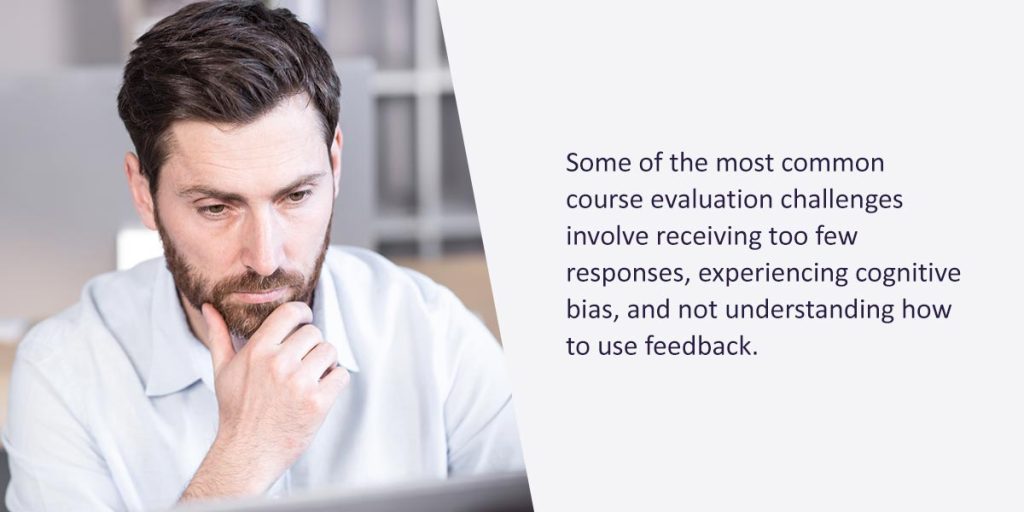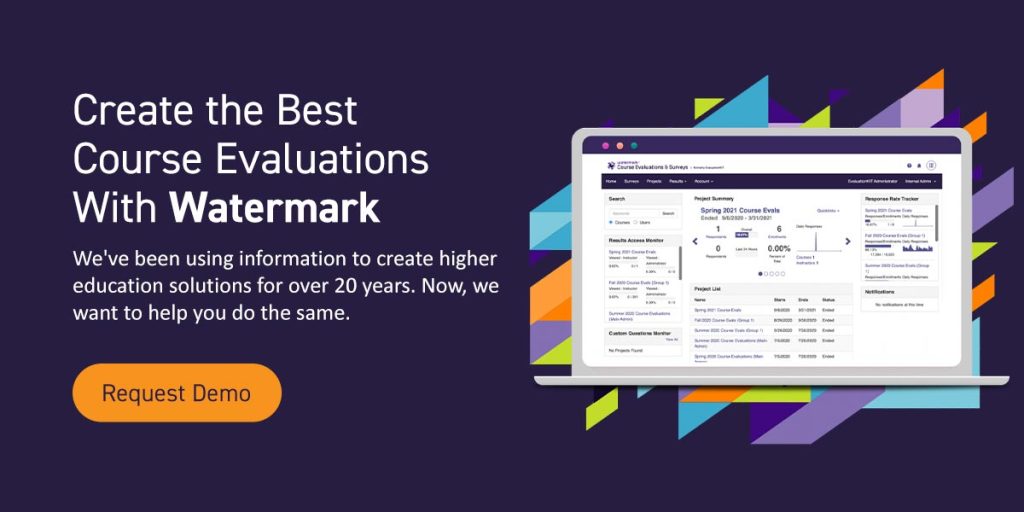



Course evaluations create opportunities for students to voice concerns and address pain points. This information helps instructors evaluate their teaching methods and adopt practices that will further engage more students. Institution administrators use student data to set initiatives, support decisions, and create an enriching campus experience.
However, many institutions conduct poor course evaluations. Even worse, many institutions don’t know how to use their student feedback properly. Join the ranks of higher ed institutions that conduct meaningful assessments and drive change with student data. Take a look at our all-in-one course evaluation solution to discover how you can improve your institution.
A course evaluation is a way to collect students’ thoughts and opinions about a class, course materials, and instructors. These assessments have a defined purpose. Students complete short answer statements, complete opened-ended questions, or use a scale system to rate various topics.
Creating a course evaluation requires identifying and targeting a goal. Each assessment provides meaningful insight into the student experience that administrators can use to improve their institution and reshape the classroom curriculum. Most course evaluations occur at the end of the semester, but some institutions also use early and halfway evaluations to assess whether the instructor and coursework reflect the syllabus and objectives.
Instructors may distribute course evaluations in class and give students time to complete them. Many institutions use an online course evaluation system so students can finish the surveys anonymously and when it’s convenient for them. Establishing an online evaluation system can help boost response rates and encourage students to be more critical, giving you more information to work with.
Data changes higher education. As a higher education institution, your top priority should be creating an exceptional environment that supports student learning. You can use student course evaluations to improve campus learning and create a more enriching student experience.
If you’re using data to improve student learning, evaluate programs and courses regularly. Institutions can experience small changes, such as helping structure a new course, and significant changes, like shaping an entire department. Programs needing drastic changes make it challenging for learners to succeed. Student response can help you jump on these pain points and adjust the curriculum to reduce these barriers.
Collecting data can help you make future predictions, enabling you to make changes before a problem arises or dedicate resources to develop a more engaging curriculum over time. Reviewing course evaluations helps you identify patterns and make changes accordingly. Students may detail new assignments they would like to see or a curriculum addition that creates an engaging environment. Many institutions have updated their curriculum to include more real-life examples, simulation exercises, and dataset manipulation due to student feedback.
Course evaluations provide many benefits for instructors, students, and administrators. Course evaluations allow institution decision-makers to improve course quality and ensure students receive the worthwhile education they seek. Students can appreciate the opportunity to address campus and classroom concerns that affect their education. Instructors can use student feedback to assess their teaching methods and make changes to engage more students.
Other benefits of course evaluations include:

Although course evaluations present many benefits for higher education institutions, they also come with potential challenges. Some of the most common course evaluation challenges involve receiving too few responses, experiencing cognitive bias, and not understanding how to use feedback.
Despite the importance of course evaluations, many students opt to neglect these assessments. Some would rather not spend the time to finish it while others forget.
It can also be challenging for students to overcome bias when they evaluate an instructor or course. Some students may feel an educator with strict grading policies deserves low scores despite the effectiveness of the course. Many students will reflect only on the course’s last few days or weeks. Quality student responses can drive change, but only if you know how you plan to use them.
To address these challenges, break them down. For instance, you can boost student responses by making your course evaluations available online and expressing their importance and your goals. Students may feel more inclined to complete the assessment when they know they can do it when it’s convenient for them. Knowing they can shape their education can also be a motivator.
You can further boost response rates by providing an incentive for finishing course evaluations. Some institutions encourage students to use a campus email or similar information to enter a giveaway for cash prizes, gift cards, and school gear after they complete the assessment.
Tackle cognitive bias by incorporating surveys throughout the semester. Evaluate how students feel at the end of the course compared to the beginning or middle rather than only relying on end-of-semester data. Ensure your questions are specific and measurable. Your evaluations should also have a clear purpose. This purpose will help you determine how to use your student data and enable you to create specific questions for each assessment.
Watermark Course Evaluations & Surveys is a higher ed solution to collecting and analyzing student feedback. You can use your responses to improve learning outcomes and create an enriching experience for your students. Our software simplifies the data collection process, making it easier to track trends and drive institutional change.
Watermark solutions turn survey responses into actionable insights. Our software provides institutions with all the information they need to make informed decisions to improve student success. We can help you define your purpose and ask the right questions to support your decisions. Our solutions help you create the best course evaluations, and you can use that information to shape campus experiences.
We make it easy to gather data in one place and share it with your team. Spread your messages and identify your initiatives while using student data to support them. Using our software, you can eliminate the time it takes to distribute, assess, and share information. Rather than manually analyzing every piece of feedback, you can create customizable reports and easily share them with your team for review.
Our solutions can also help boost response rates. We can help you join other institutions engaging more students, such as Roanoke-Chowan Community College, which experienced a more than doubled student response rate with Watermark.

At Watermark, we’re driven by data. We’ve been using information to create higher education solutions for over 20 years. Now, we want to help you do the same. With an experienced team of education professionals, we know what it takes to empower, improve, and evolve student success. Request a demo of Watermark Course Evaluations & Surveys today and experience the change for yourself.





























































































































































































































































































































































































